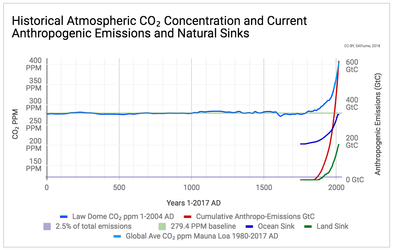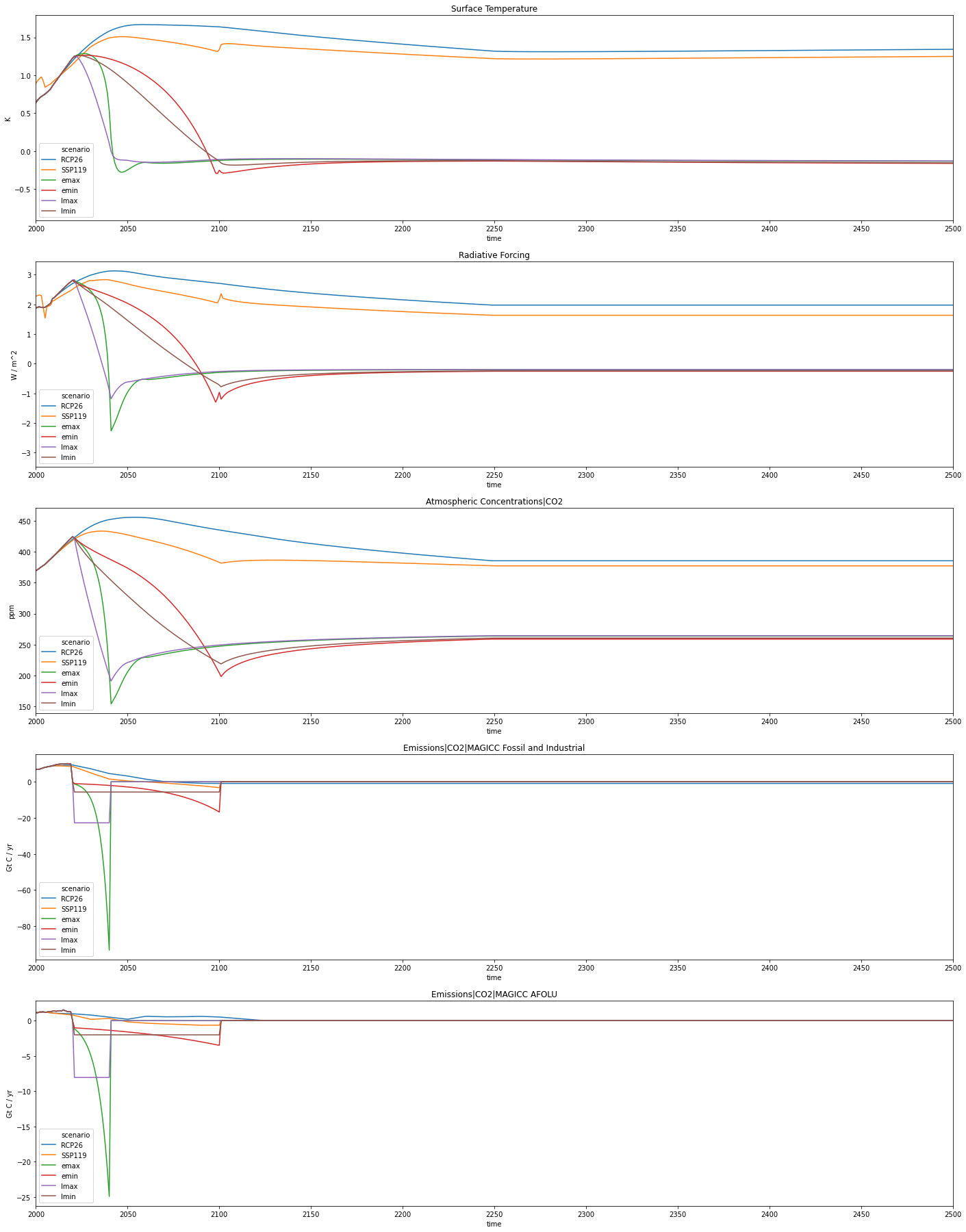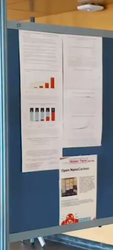| Table of Contents |
|---|
| Page Properties | ||||||||||||||
|---|---|---|---|---|---|---|---|---|---|---|---|---|---|---|
|
Status
Collaboration with Foundation for Climate Restoration on a brief using MAGICC 6.8 is in progress. Experiments to test 300 ppm, then to 280 ppm, and calibrating MAGICC 6.8 for removal is in progress. Seeking additional funding for a full detailed paper.
The full experimental paper is on hold until the experiments can be rerun on a full CDRMIP Atmosphere-Ocean General Circulation Model. Once the experiments are run on a full AOGCM the results will more accurately (compared to a Reduced-complexity Model such as MAGICC 6.8) show if the hypothesis of halting anthropogenic emissions from all greenhouse gasses and additionally remove cumulative anthropogenic carbon dioxide, would restore the climate to that existed at 1800 with a CO₂ concentration of about 280 ppm.
Note, a brief commentary on Reduced Complexity Model results may have limited impact as the experiments would need to be repeated on a cluster running the full AOGCM to better project the impact of strong feedbacks.
Papers
Theory paper
Presented version: Targeting All Anthropogenic Carbon Dioxide Emissions
Revised version: Alternative Method to Determine a Carbon Dioxide Removal Target (2018)
https://doi.org/10.1002/essoar.10503117.1
Authors: Shannon A. Fiume
Short paper outlining how much carbon we need to solidify for complete climate restoration and the carbon's location. Shows why 300 ppm and less needs to be fully explored for complete climate restoration.
Experimental Validation Paper
Working draft title 'Modeling of large-scale CDR Scenarios'.
Experimental validation of Targeting All Anthropogenic Carbon Dioxide Emissions with MAGICC 6, and pymagicc.
Authors: Shannon A. Fiume
Abstract
The experiments explore the effects of halting anthropogenic emissions from all greenhouse gasses and additionally removing cumulative anthropogenic carbon dioxide in less than 100 years. Two pairs of idealized greenhouse gas emissions modeling experiments were completed in MAGICC 6.801, a Reduced Complexity Model. The experiment pair explores the difference between exponential removal and linear removal for both a forty- and eighty-year time frame. Results were graphed, extending to 2500, showing a converging temperature, greenhouse concentration, and warming. The Reduced Complexity climate model, when all greenhouse gas emissions were halted, and cumulative anthropogenic carbon dioxide was removed, excluding ammonia under .1ºC of warming was realized.
Results Summary
The experiments removed all anthropogenic carbon dioxide and2021 Results
Current results in pymagicc/MAGICC 6.8: https://github.com/hsbay/cdrmex, https://github.com/hsbay/cdrmex/blob/main/ONCtests.ipynb
2018 Results
The experiments removed all anthropogenic carbon dioxide and forced all other GHGs to zero, excluding ammonia, which resulted in under .1ºC of warming.
Graphs of Experiment Scenarios | CO₂ ppm | CO₂-eq ppm | CO₂ RF W/m² | Total Anthro RF W/m² | Global Temp ºC |
|---|---|---|---|---|---|
278.4 | 277.4 | 0.0268 | -0.0244 | 0.0771 | |
278.9 | 277.8 | 0.037 | -0.0171 | 0.0825 | |
| Minimum Exponential Decline CDR Scenario (emin) | 273.6 | 275.3 | -0.0655 | -0.0653 | 0.0546 |
| Minimum Linear Decline CDR Scenario (lmin) | 275.9 | 276.4 | -0.0206 | -0.0424 | 0.0719 |
Mean | 276.7 | 276.7 | -0.0056 | -0.0373 | 0.0715 |
Std dev | 1.9 | 0.9 | 0.0375 | 0.0166 | 0.0085 |
Pymagicc output: Shows SSP-1 1.9 in orange. The graphing artifacts for SSP 1 1.9 are due to errors in the dataset from bugs in pymagicc and ipcc explorer data output. The raw MAGICC output is also shown in the links to the Graphs of Experiment Scenarios above.
Data Area2018 Data
CSV of control files (Also see the SCENemax, SCENlmax, etc. tabs in Total Emitted Carbon Graphs and Comparisons gsheets)
- EMAX - https://drive.google.com/open?id=1ixSjWiY4vZ5wGMTBdQZvSfpA9Xa-wkZi
- LMAX https://drive.google.com/open?id=165v1m4NYZ9H2krOxFIJiAgsMCwbxSb_F
- EMIN - https://drive.google.com/open?id=1ldRhdefresrCUeedRyO5QqUcB4U1LASA
- LMIN - https://drive.google.com/open?id=1CUn6_xZeT7z9FcQP9NIH9mhdUsvQFemJ
SCEN Control files
2021 Code
AreaRepository
CDR Modeling Experiment Github repository: https://github.com/hsbay/cdrmex
Dependencies
- wine - Wine Is Not an Emulator, emulation software for running Windows programs on Linux and Unixes including MacOS
- pymagicc
Pymagicc will install the following:
MAGICC 6.801
jupyter
Code to translate CSVs and display scenarios are forthcoming.
SSP Database, International Institute for Applied Systems Analysis: https://tntcat.iiasa.ac.at/SspDb, About page
Bugs
| Issue Status | Title | ||
| open | Calibrate MAGICC6.8 for Negative Emissions #6 | open | Change baseline to mean of 1720 to 1800 #5 |
Reference Papers
Emulating coupled atmosphere-ocean and carbon cycle models with a simpler model, MAGICC6 – Part 1: Model description and calibration, Meinshausen, M., Raper, S. C. B., and Wigley, T. M. L., Atmos. Chem. Phys., 11, 1417-1456, DOI: 10.5194/acp-11-1417-2011, 2011
Emulating atmosphere-ocean and carbon cycle models with a simpler model, MAGICC6 – Part 2: Applications, Meinshausen, M., Wigley, T. M. L., and Raper, S. C. B., Atmos. Chem. Phys.,11, 1457–1471, DOI: 10.5194/acp-11-1457-2011, 2011
Global Carbon Budget 2017, Le Quéré, C., Andrew, R. M., Friedlingstein, P., Sitch, S., Pongratz, J., Manning, A. C., Korsbakken, J. I., Peters, G. P., Canadell, J. G., Jackson, R. B., Boden, T. A., Tans, P. P., Andrews, O. D., Arora, V. K., Bakker, D. C. E., Barbero, L., Becker, M., Betts, R. A., Bopp, L., Chevallier, F., Chini, L. P., Ciais, P., Cosca, C. E., Cross, J., Currie, K., Gasser, T., Harris, I., Hauck, J., Haverd, V., Houghton, R. A., Hunt, C. W., Hurtt, G., Ilyina, T., Jain, A. K., Kato, E., Kautz, M., Keeling, R. F., Klein Goldewijk, K., Körtzinger, A., Landschützer, P., Lefèvre, N., Lenton, A., Lienert, S., Lima, I., Lombardozzi, D., Metzl, N., Millero, F., Monteiro, P. M. S., Munro, D. R., Nabel, J. E. M. S., Nakaoka, S.-I., Nojiri, Y., Padin, X. A., Peregon, A., Pfeil, B., Pierrot, D., Poulter, B., Rehder, G., Reimer, J., Rödenbeck, C., Schwinger, J., Séférian, R., Skjelvan, I., Stocker, B. D., Tian, H., Tilbrook, B., Tubiello, F. N., van der Laan-Luijkx, I. T., van der Werf, G. R., van Heuven, S., Viovy, N., Vuichard, N., Walker, A. P., Watson, A. J., Wiltshire, A. J., Zaehle, S., and Zhu, D., Earth System Science Data, 10, pp. 405-448, DOI: 10.5194/essd-10-405-2018, 2018
The Shared Socioeconomic Pathways and their energy, land use, and greenhouse gas emissions implications: An overview, Keywan Riahi, Detlef P. van Vuuren, Elmar Kriegler, Jae Edmonds, Brian C. O’Neill, Shinichiro Fujimori, Nico Bauer, Katherine Calvin, Rob Dellink, Oliver Fricko, Wolfgang Lutz, Alexander Popp, Jesus Crespo Cuaresma, Samir KC, Marian Leimbach, Leiwen Jiang, Tom Kram, Shilpa Rao, Johannes Emmerling, Kristie Ebi, Tomoko Hasegawa, Petr Havlík, Florian Humpenöder, Lara Aleluia Da Silva, Steve Smith, Elke Stehfest, Valentina Bosetti, Jiyong Eom, David Gernaat, Toshihiko Masui, Joeri Rogelj, Jessica Strefler, Laurent Drouet, Volker Krey, Gunnar Luderer, Mathijs Harmsen, Kiyoshi Takahashi, Lavinia Baumstark, Jonathan C. Doelman, Mikiko Kainuma, Zbigniew Klimont, Giacomo Marangoni, Hermann Lotze-Campen, Michael Obersteiner, Andrzej Tabeau, Massimo Tavoni, Global Environmental Change, Volume 42, Pages 153-168, ISSN 0959-3780, DOI: 110.1016/j.gloenvcha.2016.05.009, 2017
Energy, land-use and greenhouse gas emissions trajectories under a green growth paradigm, SSP1: Detlef P. van Vuuren, Elke Stehfest, David E.H.J. Gernaat, Jonathan C. Doelman, Maarten van den Berg, Mathijs Harmsen, Harmen Sytze de Boer, Lex F. Bouwman, Vassilis Daioglou, Oreane Y. Edelenbosch, Bastien Girod, Tom Kram, Luis Lassaletta, Paul L. Lucas, Hans van Meijl, Christoph Müller, Bas J. van Ruijven, Sietske van der Sluis, Andrzej Tabeau, Global Environmental Change, Volume 42, Pages 237-250, ISSN 0959-3780, DOI 10.1016/j.gloenvcha.2016.05.008, 2017
, , , D. Beerling, R. Berner, V. Masson-Delmotte, M. Pagani, M. Raymo, D.L. Royer, and J.C. Zachos, Open Atmos. Sci. J., 2, 217-231, DOI: 10.2174/1874282300802010217, 2008
Related Papers
The Carbon Dioxide Removal Model Intercomparison Project (CDR-MIP): Rationale and experimental protocol for CMIP6, Keller, D. P., Lenton, A., Scott, V., Vaughan, N. E., Bauer, N., Ji, D., Jones, C. D., Kravitz, B., Muri, H., and Zickfeld, K., Geosci. Model Dev., DOI: 10.5194/gmd-2017-168, 2018.
The SSP greenhouse gas concentrations and their extensions to 2500, Meinshausen, M., Nicholls, Z., Lewis, J., Gidden, M. J., Vogel, E., Freund, M., Beyerle, U., Gessner, C., Nauels, A., Bauer, N., Canadell, J.P., Daniel, J.S., John, A.,Krummel, P., Luderer, G., Meinshausen, N., Montzka, S., Rayner, P., Reimann, S., Smith, S.J., van den Berg, M.,Velders, G.J.M., Vollmer, M., Wang, H.J.R., DOI: 10.5194/gmd-2019-222, 2019 (preprint)
Reduced Complexity Model Intercomparison Project Phase 1:introduction and evaluation of global-mean temperature response, https://doi.org/10.5194/gmd-13-5175-2020
Zebedee R. J. Nicholls1,2, Malte Meinshausen1,2,3, Jared Lewis1, Robert Gieseke4, Dietmar Dommenget5,Kalyn Dorheim6, Chen-Shuo Fan5, Jan S. Fuglestvedt7, Thomas Gasser8, Ulrich Golüke9, Philip Goodwin10,Corinne Hartin6, Austin P. Hope11, Elmar Kriegler3, Nicholas J. Leach12, Davide Marchegiani5, Laura A. McBride13,Yann Quilcaille8, Joeri Rogelj8,14, Ross J. Salawitch11,13,15, Bjørn H. Samset7, Marit Sandstad7,Alexey N. Shiklomanov6, Ragnhild B. Skeie7, Christopher J. Smith8,16, Steve Smith6, Katsumasa Tanaka17,18,Junichi Tsutsui19, and Zhiang Xie
Is there warming in the pipeline? A multi-model analysis of the Zero Emissions Commitment from CO₂, https://doi.org/10.5194/bg-17-2987-2020
Andrew H. MacDougall1, Thomas L. Frölicher2,3, Chris D. Jones4, Joeri Rogelj5,6, H. Damon Matthews7,Kirsten Zickfeld8, Vivek K. Arora9, Noah J. Barrett1, Victor Brovkin10,11, Friedrich A. Burger2,3, Micheal Eby12,Alexey V. Eliseev13,14, Tomohiro Hajima15, Philip B. Holden16, Aurich Jeltsch-Thömmes2,3, Charles Koven17,Nadine Mengis18, Laurie Menviel19, Martine Michou20, Igor I. Mokhov13,14, Akira Oka21, Jörg Schwinger22,Roland Séférian20, Gary Shaffer23,24, Andrei Sokolov25, Kaoru Tachiiri15, Jerry Tjiputra22, Andrew Wiltshire4, andTilo Ziehn2
A solution to the misrepresentations of CO2-equivalent emissions of short-lived climate pollutants under ambitious mitigation, Myles R. Allen, Keith P. Shine, Jan S. Fuglestvedt, Richard J. Millar, Michelle Cain, David J. Frame & Adrian H. Macey, npj Climate and Atmospheric Science, volume 1, Article number: 16, DOI: 10.1038/s41612-018-0026-8, 2018
, PNAS, , DOI: 10.1073/pnas.1810141115, 2018
Estimating Changes in Global Temperature since the Preindustrial Period, Ed Hawkins, Pablo Ortega, Emma Suckling, Andrew Schurer, Gabi Hegerl, Phil Jones, Manoj Joshi, Timothy J. Osborn, Valérie Masson-Delmotte, Juliette Mignot, Peter Thorne, and Geert Jan van Oldenborgh, DOI: 10.1175/BAMS-D-16-0007.1, 2017
Halocarbon scenarios, ozone depletion potentials, and global warming potentials, Daniel, J.S., and G.J.M. Velders (Lead Authors), A.R. Douglass, P.M.D. Forster, D.A. Hauglustaine, I.S.A. Isaksen, L.J.M. Kuijpers,A. McCulloch, and T.J. Wallington, Chapter 8 in Scientific Assessment of Ozone Depletion: 2006, Global Ozone Research and Monitoring Project—Report No. 50, 572 pp., World Meteorological Organization, Geneva, Switzerland, 2007
On the proportionality between global temperature change and cumulative CO2 emissions during periods of net negative CO2 emission, Kirsten Zickfeld, Andrew H MacDougall,and H Damon Matthews, doi:10.1088/1748-9326/11/5/055006, 2016


